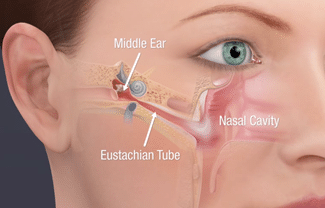My hearing is muffled but there is no ear wax?
I have had a few clients attend Valley Hearing recently reporting muffled hearing. When I check their ears there is definitely no ear wax, so what is going on? There could be a number of reasons. One is Eustachian Tube Dysfunction, but what on earth is that?
What is the Eustachian Tube?
It is the tube that connects the middle ear to the back of the nose. It is
important for:
· regulating the balance of pressure between the ear and the outside world
· clearing fluid and secretions from behind your ear drum
It is usually closed, and temporarily opens when swallowing, yawning, chewing or sneezing.
What is Eustachian Tube Dysfunction
(ETD)?
It is a common condition affecting about 2 out of 100 adults of any age but
it is more common in children. It is a condition where the tube is not working
properly. This can lead to problems with the ear, including:
· fluid behind the ear (glue ear),
· a sunken in (retracted) ear drum
· chronic ear infections
What are the symptoms of ETD?
Common symptoms include:
• a sensation of fullness or blockage of the ear
• popping or crackling sounds
• discomfort/pain of ears which usually comes and goes
• reduced or muffled hearing
• ringing in the ears (tinnitus)
• abnormal sound of your own voice (autophony).
What causes ETD?
The Eustachian tube is narrow and can become blocked, or not open properly.
We don’t really know why it happens, but ETD is more common in people with:
• a recent cold or viral respiratory illness
• chronic nasal inflammation, including hayfever or sinus infections
• smokers
• acid re-flux
• significantly raised body mass index (BMI)/obese patients
• blockage at the back of the nose (including enlarged adenoid tissue, or scarring from
• radiotherapy to the head and neck).
What If you only get symptoms
when flying or scuba diving?
ETD symptoms are common with changes in altitude or pressure, so can flare
up when flying or scuba diving. These symptoms are often temporary and simple
actions including chewing gum, swallowing, sucking on a sweet or yawning often
help.
How is ETD diagnosed?
There is no simple test for ETD, the diagnosis depends on a visual
examination of your ears, a hearing test and a pressure test of the ear
canal. Referral to your GP/ENT may be
required.
What are the treatment options?
Non surgical
If the symptoms have been associated with a cold or viral respiratory
illness, it normally gets better when the infection goes away. Other treatments
include:
• saline (salt water) nasal rinses
• nasal steroid drops or spray
• antihistamine tablets
• a short course of nasal decongestants
Surgical
Surgery is usually only for patients with chronic or severe symptoms that
do not respond to other treatments. Options include:
• Adenoidectomy – the tissue at the back of your nose is removed under general anesthetic
• ventilation tube insertion (grommets)
• balloon dilation Eustachian tuboplasty

